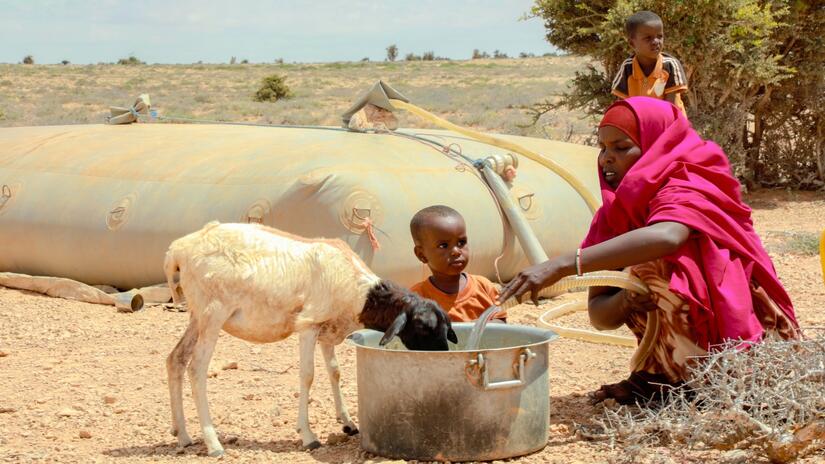This blog was originally posted on the WWF website here.
Africa is facing its worst food crisis in 40 years. Nearly 114 million people across sub-Saharan Africa – a figure approaching half the entire population of the United States – face severe food insecurity. In Eastern Africa, 50 million people are at risk. Across the Sahel, the number of people needing emergency food assistance has quadrupled to 30 million in the past seven years.
The causes of this current crisis are manifold. Conflict and the economic downturn caused by the COVID-19 pandemic have played their part. But more significantly, the continent has been wracked by prolonged drought, flooding and swarms of desert locusts – natural hazards, exacerbated by man-made climate change and the degradation of nature.
It is the most vulnerable who are bearing the brunt of the current hunger crisis. Men and women are losing their livelihoods as crops fail, animals starve or die of thirst, and soil is washed away. Children go hungry, and their education is abandoned. Women eat less, and drought means dietary requirements, especially for young girls, pregnant and lactating women, and menstrual hygiene are relegated.
There is an urgent need for life-saving humanitarian assistance in all countries in Africa. Organizations such as Red Cross and Red Crescent Societies are stepping up their actions, with the IFRC, governments and partners, to provide this urgent support. But they recognize, as does WWF, the need to also build resilience to shocks and to address the root causes of food insecurity.
A changing climate
Many underlying causes can be found in the twin environmental crises of climate and nature loss, which are compounded with the crises caused by factors including poverty and conflict. The rising levels of greenhouse gases in our atmosphere – primarily from the rich and middle-income countries of the global North – are driving temperature rises that are disrupting weather and climate patterns and degrading natural ecosystems.
Climate change is making extreme weather events worse, more frequent and more trans-boundary. It is changing patterns of precipitation, undermining water and food security. It is impacting human health, as well as putting additional stress on nature and biodiversity, exacerbating pressures from land-use change, over-exploitation, pollution and invasive species.
Presently, around 30 per cent of all greenhouse gas emissions come from food systems. Not only are food choices in rich, urban areas leading to a health crisis of obesity and non-communicable disease, but the over-consumption of unsustainably produced foods, and inefficient and wasteful behaviours across all value chains, are directly contributing to food insecurity in Africa.
This underscores the urgent imperative for rich countries to reduce emissions as quickly as possible. Even if all other sectors linearly decarbonise by 2050, business as usual food systems will account for nearly the whole carbon budget of a 2 degree future.
While around 89 countries have pledged to reach net-zero emissions by the middle of this century (which would still not deliver the emissions cuts needed to limit warming to 1.5°C), few have yet developed the suite of policies and regulations that will put them on a net-zero trajectory.
Many vulnerable communities in Africa need to be supported in the face of climate shocks by strengthening their capacity to respond, reducing their risk exposure and building their resilience.
There is much that can and should be done to directly help vulnerable communities and ecosystems in Africa today and in the decades to come.
Urgent investment must be made to help vulnerable communities adapt to the current impacts of climate change, and to become more resilient to climate shocks yet to come. Critically, this involves building a shared understanding, securing financing and enacting favourable policies so that governments, NGOs and the private sector in Africa can recognise the threats posed by the impacts of climate change and implement the urgent solutions needed to help local people adapt.
The link between climate and nature
Significant solutions also exist that use nature to both mitigate greenhouse gas emissions and to help communities to adapt and become more climate resilient.
The world’s land, oceans and freshwater systems already absorb and store half of the emissions humankind produces each year: protecting, restoring and enhancing ecosystems will be critical to addressing climate change. Food systems can also be a major part of the solution to the nature and climate crises.
Investment in nature-based solutions – such as adopting agroecological food production practices, forest conservation, protecting wetlands or enhancing coastal ecosystems – can help store emissions, protect communities from extreme weather events, and provide food, jobs and habitats. Such solutions, if high quality, well-designed and properly funded, can help build climate resilience.
But as well as individual projects, climate impacts and vulnerabilities, and the protection of nature, must be integrated into public- and private-sector decision-making at every level across the continent. The extent of the challenge posed by climate and nature loss means that they need to be considered across all levels of decision-making and by economic actors large and small.
The current food crisis faced by millions across Africa demands urgent humanitarian aid. But, without a much more comprehensive and long-term, locally-led, people-centred response to climate change and biodiversity loss, humanitarian resources will be stretched beyond breaking point.
---
The IFRC is partnering with WWF, the world's largest environmental conservation organization, to work with nature and protect people from the climate crisis. Click here to learn more about our partnership.





